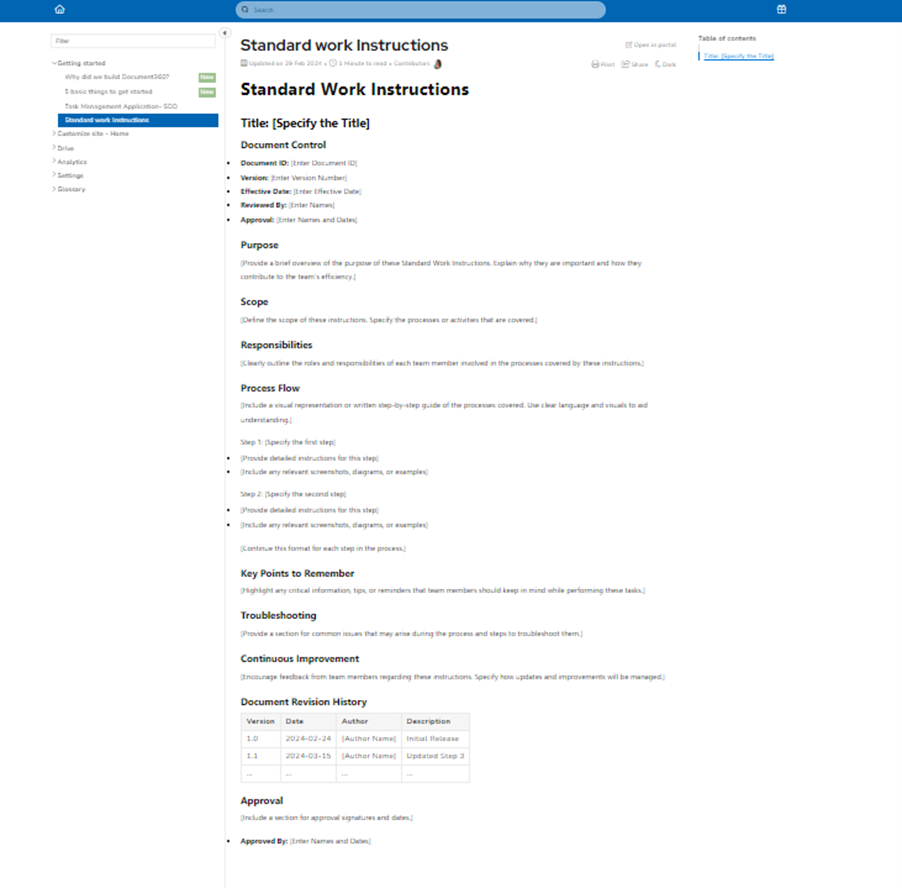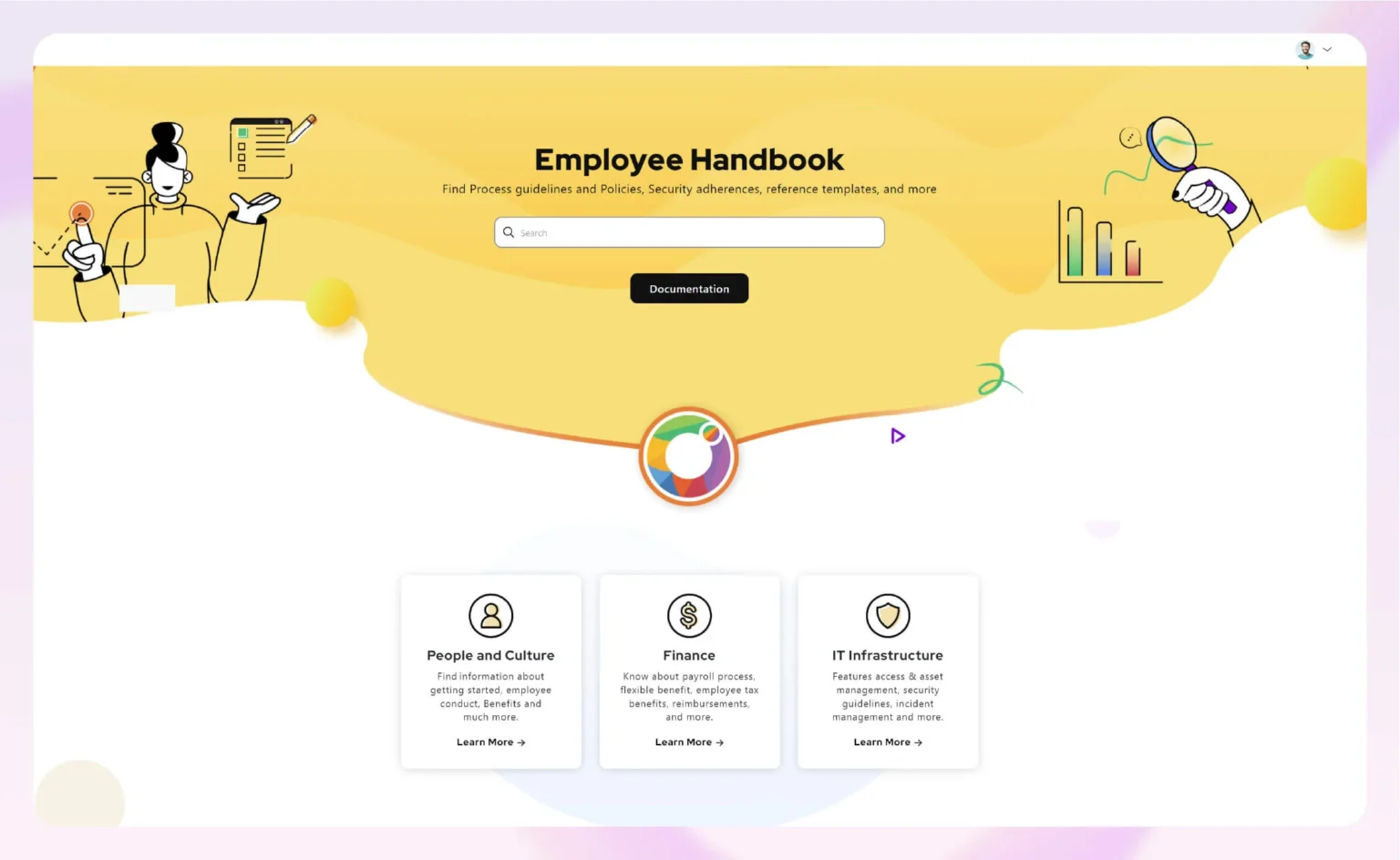When done right, standard work instructions (SWIs) can take your company from sluggish to superhuman. We’re talking about better processes, improved communication, and happier employees.
But the truth is, a lot of companies don’t get it right. Imagine creating an SWI that further complicates the work process – disaster!
And that’s what we’d be discussing today.
Understanding Standard Work Instructions (SWIs)
What are standard work instructions?
According to the Lean Enterprise Institute, “SWIs are written instructions that explain the best and most efficient way to do a specific job or task.”
For instance, in a smartphone manufacturing industry, SWIs would guide workers through each step of assembling the phone, all the way to the final checks for quality. Sometimes, there might be a flowchart showing the assembly steps visually.
Good to note: SWIs are not to be confused with Standard Operating Procedures (SOPs) – comprehensive guides for different aspects of a company. SWIs deal with one specific job/process, while SOPs address multiple tasks.
Key Elements of Standard Work Instructions
Here are some of the key elements of any SWI…
Takt time
Think of takt time as the pace at which you must work to meet your customers’ wants.
So let’s say your customers need new software updates every week. The takt time would be one week.
Takt time is like an accountability partner. It helps you and your team work at a pace that meets customer expectations — completing and delivering updates within a given time.
Work sequence
Work sequence is the specific order of tasks you and your team need to follow so you can deliver services within a takt time.
Put simply, a work sequence is like a to-do list.
Let’s say you work for a company that sells software services to other businesses. The order of tasks to follow to deliver the software on time may include:
Get the client’s requirements → Plan and design the software → Develop the software → Test the software for quality → Deploy the software → Train users on how to use it → Implement the software → Provide ongoing support and maintenance.
You get the drift.
Standard work in process/Standard inventory
Standard work in process is all about having the right amount of materials or supplies at every stage of production to ensure a steady workflow and meet customer demands.
Benefits of Standard Work Instructions
Creating standard work instructions will take some time and effort. So, why bother doing it?
Well, it comes with a ton of benefits, including:
Enhancing Efficiency and Quality
SWIs in your business mean fewer mistakes from team members and everyone knows what’s going on and what to do at any given time. This means less work, more time, and more money for you and your team.
More money? Yes. Repeating tasks and making mistakes costs lots of money.
Let’s use customer support as an example. Without an SWI, the team would lack clarity and cohesion, which would cause customers to churn.
Customer churn = Money in the drain.
If the customer support team has unambiguous directions, they can swiftly and effectively handle incoming customer complaints. The customers are happy, employees are relieved, and more money is in the bank for the business.
Consistency in Processes
Consistency in processes happens when there’s a strong, detailed routine outlining specific directives on each job task. This makes sure each step is performed the same way across teams. The directives help sustain the identical results from every effort, providing a more structured, predictable process.
For example, a B2B marketing team that hires freelance writers should follow the same process and give the same instructions (brand guidelines, if you will) to all writers.
Why? To avoid inconsistencies.
By following an exact process, the blogs and marketing materials would be more consistent and cohesive across the board regardless of who wrote what.
Improved Quality Control
Poor quality control means a lot of mistakes, unhappy workers, and expensive operations. This is where you need standard work instructions.
For instance, you can set up an SWI where everyone records data the same way. This means that the information recorded is stable and reduces issues with data quality control.
An instruction manual for SWI would also benefit teams in technical support, allowing them to work better together and respond to customers more effectively.
Enhanced Training and Onboarding
When companies want to onboard new employees, they often rely on in-person training and coaching, which are both time-consuming and expensive.
SWIs speed up the onboarding process. By giving new employees clear instructions about how the products work and how to handle customer problems, it becomes easier to get new employees up to speed without missing anything.
The need for in-person training will also be eliminated which will save cost and time. And the employees also get to learn at their own pace and grasp new concepts quickly.
Reduced Errors and Rework
Standard work instructions give clear instructions to employees, reducing the likelihood that they will make mistakes as they work.
For instance, in a SaaS company, getting product development and service delivery right is essential to success.
Software developed using standardized code will have fewer bugs and errors. With consistent coding standards, there’s less need to do things once and then over again, creating better quality products. This makes an organization more reliable – delivering accurate and high-quality software to customers creates trust and satisfaction.
Time and Cost Savings
It’s often common for employees to face some mental blocks during tasks, due to miscommunication, information silos, or as simple as they just don’t know what to do. This is where Standard work instructions come in.
By standardizing tasks, you break down any mental blocks (and information silos) because everyone is following the same, clear, and updated process. This method speeds up tasks by eliminating unnecessary blocks, which will, in turn, save time and reduce labor costs.
We’ve talked about how saving time reduces expenses (See the 1st benefit – enhancing efficiency and quality).
Interested in Document360 Knowledge Base? Schedule a demo with one of our experts
Book A Demo
Best Practices of Standard Work Instructions
In this section, let’s discuss the best practices for designing standard work instructions:
Clear and Simple Language
Standard work instructions have to be written in clear and simple words. If you’re using corporate jargon and ambiguity in your SWI, it defeats the purpose of having the instruction in the first place – to make things easier for everyone.
Avoid long and fancy words to ensure your employees understand your instructions. And that’s not all; keep it short, include pictures, organize the information right, and check that everything is clear.
Here’s a test to know if your instruction is clear enough. Go to your junior staff (intern probably), and ask them to read your instructions. If they can understand it, then you’re good to go. If they can’t, you need to revise it.
If everyone, regardless of how much they know, can understand your instructions, then your standardized work will become more effective.
Regular Review and Updates
Work instructions become obsolete within five years, and that time frame narrows with technological advances.
For your SWI to stay valid and relevant, you need to review and update it regularly. Here is a high-level strategy on how to review/update your SWI:
- Identify dated information that needs replacing.
- Incorporate new regulations that have cropped up.
- Establish a review schedule.
- Choose people who can validate and update each work instruction.
- Get feedback from the people who use the work instructions.
- Determine whether each work instruction still makes sense
- Make changes as needed.
- Notify everyone about the changes to the work instructions.
- Keep track of the revised work instructions.
Performing these tasks continuously will keep the work instructions updated and make sure that the people who need them the most – the people doing the work – can perform their work faster and with better results.
Check from users’ perspectives.
For your instructions to work, you need to get the approval of the actual users. Involving users in this process taps into their knowledge and experience and helps to share feedback that can help identify areas where the SWIs can be better and make more sense.
Doing this helps to make the instructions more user-friendly and better fit with what users need in the real world.
Employee Training and Empowerment
If you train and empower employees, they become a lot better at doing what you ask them. In that case, everything works better, faster, and safer, with lots more pride in the finished product.
Standard work instructions can help with the training, but you need to do some work before it gets there, like:
- Find out what they need to know and learn.
- Keep making guides to teach them, using different ways.
- Always ask employees for their ideas.
- Keep watching how training is going and make it better on what employees say.
Keep doing those things, and employees will be ready and excited to work. And, when they go to work, they do a marvelous job!
Determining When to Use Standard Work
Knowing when to use SWIs is very important. Below is a guide to help you understand when organizations should use SWIs:
Repetitive and Routine Tasks
When you have activities that are done regularly and have the same steps each time, you should consider SWIs. It gives you a clear plan for doing these tasks best and most effectively.
For example, in customer support, answering client questions happens often and follows a routine. Standard work instructions can be used by creating set responses and steps to deal with specific questions. This might include ready-made templates for common issues, guidelines for when things get more complicated, and a structured way to figure out and fix problems.
New Employee Onboarding
If the new team member needs to do repetitive tasks, SWIs can smooth the onboarding process.
For example, let’s say a new software developer joins a SaaS B2B company. They might need to know how to set up their accounts. They’re going to be expected to follow some number of rules about what good code looks like at the company and understand how things work.
SWIs provide a template that the technical team provides to Systems and HR. The template includes instructions for tasks like setting up JIRA and downloading the build tools, as well as how the code review process works and the coding standards everyone is supposed to be following.
Setting up the same tab order is important because each new developer is getting a consistent and thorough introduction. You just reduce the chance of forgetting something important each time you are on board.
Cross-Functional Processes
With SWIs, organizations can handle the difficulties involved in working across several different teams and make sure that all parties are indeed working toward identical goals, thereby facilitating fluid operations and minimizing errors.
For instance, SWIs make it clear who should give out certain kinds of information. So, in a product development team, this could mean notifying not only engineering and the development team but also customer support, sales, and marketing. This way, everybody knows what they need to do and what not. It also lays out rules on how to put information down on paper and track changes.
High-Volume Production and Multiple Users (Manufacturer/Health)
Think about a factory that makes smartphones in huge numbers. SWIs help you maintain the quality at different stages. Each device follows the same steps so you can make as many as you need. It minimizes error and keeps the quality of your phones the same along your production line.
In healthcare, it’s how you chart out a clear path for different teams – doctors, nurses, and administrative staff – to go about their tasks in common. From administering medications to conducting procedures to handling equipment.
SWIs are like what good teachers leave behind for substitutes – a guide for doing a good job even when the kids are screaming.
Processes Impacting Cx Experience and Time-Sensitive Tasks
SWIs often contain a repository of good (and bad) customer experiences and the processes that need to be accomplished to satisfy the customers. Using SWI in customer support makes it easier to provide high-quality service and improve customer experience.
In other words, Standard Work makes it simpler and faster to get things done. This is especially helpful during peak times or emergencies when solutions or services must be provided quickly and accurately with little time.
An intuitive SOP software to easily add your content and integrate it with any application. Give Document360 a try!
GET STARTED



Creating Effective Standard Work Instructions
Here’s a step-by-step method for creating standard work instructions. Here’s a sample template for standard work instruction.


Identify the Process
First, get a clear view of what the goals of the process are and how they fit with the organization’s vision.
What makes the process work well — is it the quality of the product, the speed, or your pricing? How does the process affect your customers’ satisfaction with your product or service? Identify the most important processes in each activity and rank them based on how critical they are to the company.
Document Current Practices
The next step is to write down how things are done. This helps set a starting point for getting better, makes sure everyone does things the same way, and helps the team talk to each other easily.
List each step clearly, saying who does what and when. Also, notice if there are any differences in how tasks are done now. Use pictures like flowcharts to show the steps simply, and include details about the tools and materials needed.
Use Visual Aids
Another way to make it easier to standardize is to use pictures. Pictures are great because they depict things that words can’t, which makes it easier for people to understand the instructions.
Define Key Performance Indicators (KPIs)
Remember the saying, “What can’t be measured, can’t be improved?”
You need to define the KPIs for your instructions. That’s the only way to check if things are going the way they should.
For instance, if your KPI is “customer satisfaction”, then by the end of implementing your instructions, you should check your customer satisfaction score to see if it increases. If it doesn’t increase (let’s say decrease), you must rethink your SWI.
Establish Version Control
Ensure that everyone is using the same, most recent information. As SWIs will necessarily change over time, particularly early on, it’s important to keep track of changes. This also makes the process of documenting it transparent — which eliminates past complaints from team members not understanding why it changed since they can see the modification history.
Integrate with Training Programs
Create a training manual in line with SWIs. Have exercises and tests in the material to make sure that everyone understands. Using these materials to train recruits is the right way to let them follow procedures. Based on what is learned from experience, inspect and revise standardized ways.
Also, don’t forget to get feedback from your employees about the training so you can know where to adjust or make changes.
Continuous Feedback and improvement
Keep getting feedback, and keep making things better! This helps you adjust to changes, find new opportunities, and improve your SWIs over time. Establish a work culture in which everybody is always trying to make things better.
Also Read : 9 Best Work Instructions Software for 2024
Document360 for Standard Work Instructions (SWIs)
Don’t know where to start with creating Standard Work Instructions (SWIs)? No SWI’s at all? Struggling to create world-class standards? Document360 allows you to create SWIs for your teams easily within the KB site.


With its intuitive interface, Document360 offers an advanced WYSIWYG editor for rich authoring experience making it perfect for publishing more formatted content. Version control helps to update and publish the content, The Content reuse feature quickly helps in avoiding duplication work and saves time. AI search features help the users quickly find the information and AI Assistant helps with personalized support and helps in continuing readers’ learning journey.
Overall, create standard work instruction to improve your workforce performance, building one with an ideal platform like Document360 helps you to experience better documentation.
An intuitive SOP software to easily add your content and integrate it with any application. Give Document360 a try!
GET STARTED








